2009 BMW Z4 SDRIVE30I reset
[x] Cancel search: resetPage 85 of 248
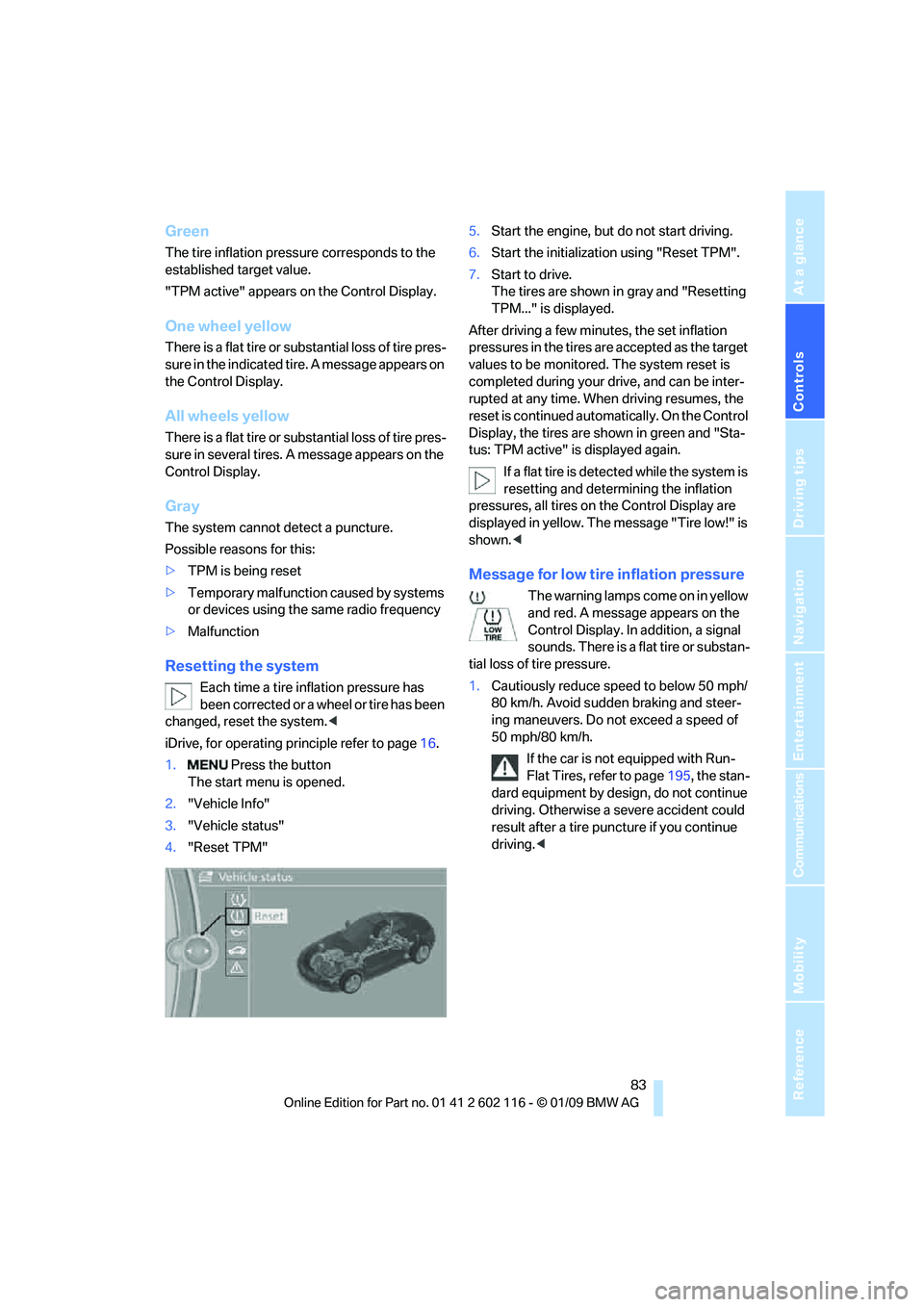
Controls
83Reference
At a glance
Driving tips
Communications
Navigation
Entertainment
Mobility
Green
The tire inflation pressure corresponds to the
established target value.
"TPM active" appears on the Control Display.
One wheel yellow
There is a flat tire or substantial loss of tire pres-
sure in the indicated tire. A message appears on
the Control Display.
All wheels yellow
There is a flat tire or su bstantial loss of tire pres-
sure in several tires. A message appears on the
Control Display.
Gray
The system cannot detect a puncture.
Possible reasons for this:
> TPM is being reset
> Temporary malfunction caused by systems
or devices using the same radio frequency
> Malfunction
Resetting the system
Each time a tire inflation pressure has
been corrected or a wheel or tire has been
changed, reset the system. <
iDrive, for operating principle refer to page 16.
1. Press the button
The start menu is opened.
2. "Vehicle Info"
3. "Vehicle status"
4. "Reset TPM" 5.
Start the engine, but do not start driving.
6. Start the initializatio n using "Reset TPM".
7. Start to drive.
The tires are shown in gray and "Resetting
TPM..." is displayed.
After driving a few minutes, the set inflation
pressures in the tires are accepted as the target
values to be monitored. The system reset is
completed during your drive, and can be inter-
rupted at any time. When driving resumes, the
reset is continued automatically. On the Control
Display, the tires are shown in green and "Sta-
tus: TPM active" is displayed again. If a flat tire is detected while the system is
resetting and determining the inflation
pressures, all tires on the Control Display are
displayed in yellow. The message "Tire low!" is
shown. <
Message for low tire inflation pressure
The warning lamps come on in yellow
and red. A message appears on the
Control Display. In addition, a signal
sounds. There is a flat tire or substan-
tial loss of tire pressure.
1. Cautiously reduce speed to below 50 mph/
80 km/h. Avoid sudden braking and steer-
ing maneuvers. Do not exceed a speed of
50 mph/80 km/h.
If the car is not equipped with Run-
Flat Tires, refer to page 195, the stan-
dard equipment by design, do not continue
driving. Otherwise a severe accident could
result after a tire punc ture if you continue
driving. <
Page 86 of 248
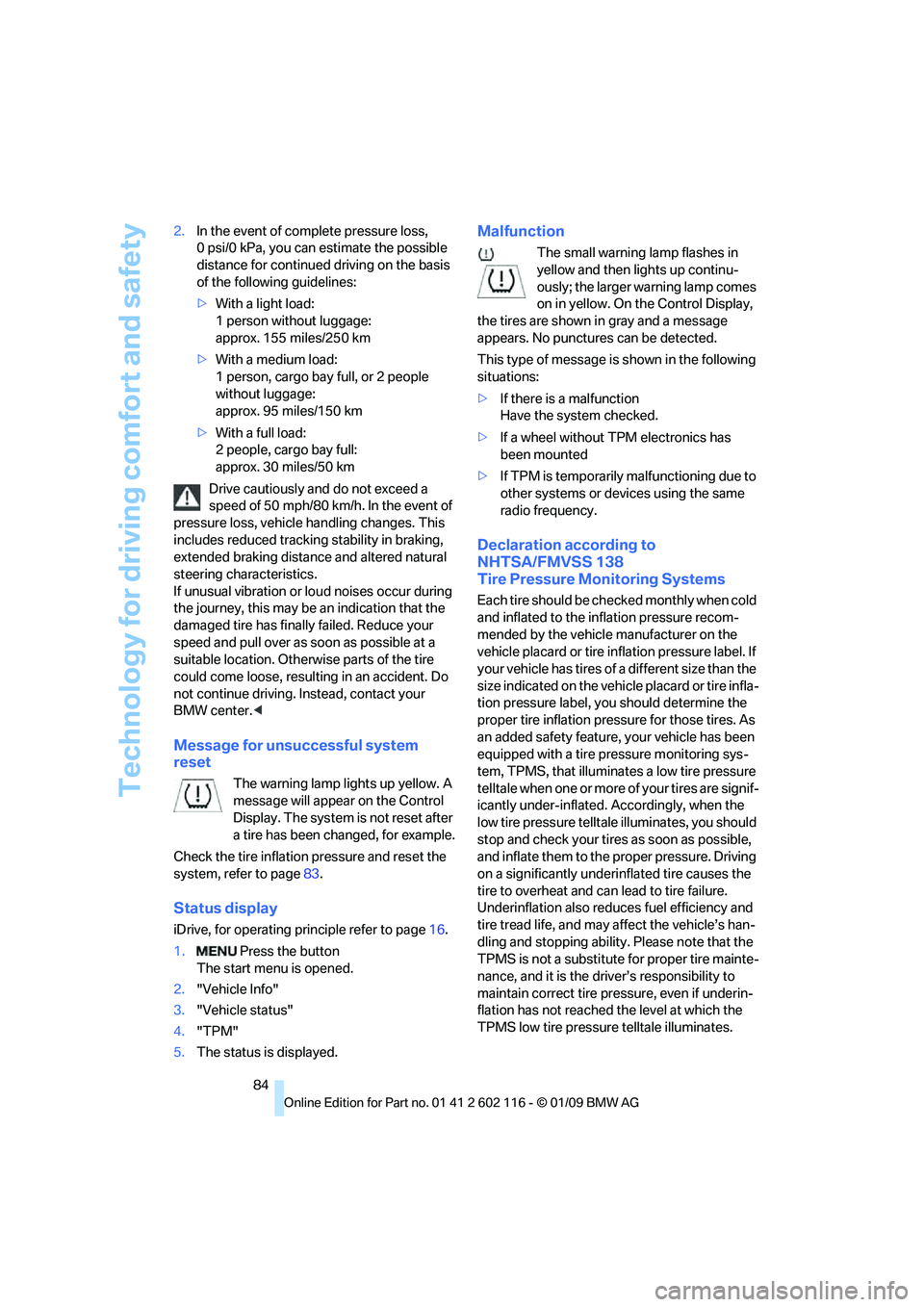
Technology for driving comfort and safety
84
2.
In the event of complete pressure loss,
0 psi/0 kPa, you can estimate the possible
distance for continued driving on the basis
of the following guidelines:
>With a light load:
1 person without luggage:
approx. 155 miles/250 km
> With a medium load:
1 person, cargo bay full, or 2 people
without luggage:
approx. 95 miles/150 km
> With a full load:
2 people, cargo bay full:
approx. 30 miles/50 km
Drive cautiously and do not exceed a
speed of 50 mph/80 km/h. In the event of
pressure loss, vehicle handling changes. This
includes reduced tracking stability in braking,
extended braking distance and altered natural
steering characteristics.
If unusual vibration or lo ud noises occur during
the journey, this may be an indication that the
damaged tire has finally failed. Reduce your
speed and pull over as soon as possible at a
suitable location. Otherw ise parts of the tire
could come loose, resulting in an accident. Do
not continue driving. Instead, contact your
BMW center. <
Message for unsuccessful system
reset
The warning lamp lights up yellow. A
message will appear on the Control
Display. The system is not reset after
a tire has been changed, for example.
Check the tire inflation pressure and reset the
system, refer to page 83.
Status display
iDrive, for operating pr inciple refer to page16.
1. Press the button
The start menu is opened.
2. "Vehicle Info"
3. "Vehicle status"
4. "TPM"
5. The status is displayed.
Malfunction
The small warning lamp flashes in
yellow and then lights up continu-
ously; the larger warning lamp comes
on in yellow. On the Control Display,
the tires are shown in gray and a message
appears. No punctures can be detected.
This type of message is shown in the following
situations:
> If there is a malfunction
Have the system checked.
> If a wheel without TPM electronics has
been mounted
> If TPM is temporarily malfunctioning due to
other systems or devices using the same
radio frequency.
Declaration according to
NHTSA/FMVSS 138
Tire Pressure Monitoring Systems
Each tire should be checked monthly when cold
and inflated to the inflation pressure recom-
mended by the vehicle manufacturer on the
vehicle placard or tire infl ation pressure label. If
your vehicle has tires of a different size than the
size indicated on the vehicle placard or tire infla-
tion pressure label, yo u should determine the
proper tire inflation pressure for those tires. As
an added safety feature, your vehicle has been
equipped with a tire pressure monitoring sys-
tem, TPMS, that illuminates a low tire pressure
telltale when one or more of your tires are signif-
icantly under-inflated. Accordingly, when the
low tire pressure telltale illuminates, you should
stop and check your tires as soon as possible,
and inflate them to the proper pressure. Driving
on a significantly underi nflated tire causes the
tire to overheat and ca n lead to tire failure.
Underinflation also reduces fuel efficiency and
tire tread life, and may affect the vehicle’s han-
dling and stopping ability. Please note that the
TPMS is not a substitute for proper tire mainte-
nance, and it is the dr iver’s responsibility to
maintain correct tire pressure, even if underin-
flation has not reached the level at which the
TPMS low tire pressure telltale illuminates.
Page 142 of 248
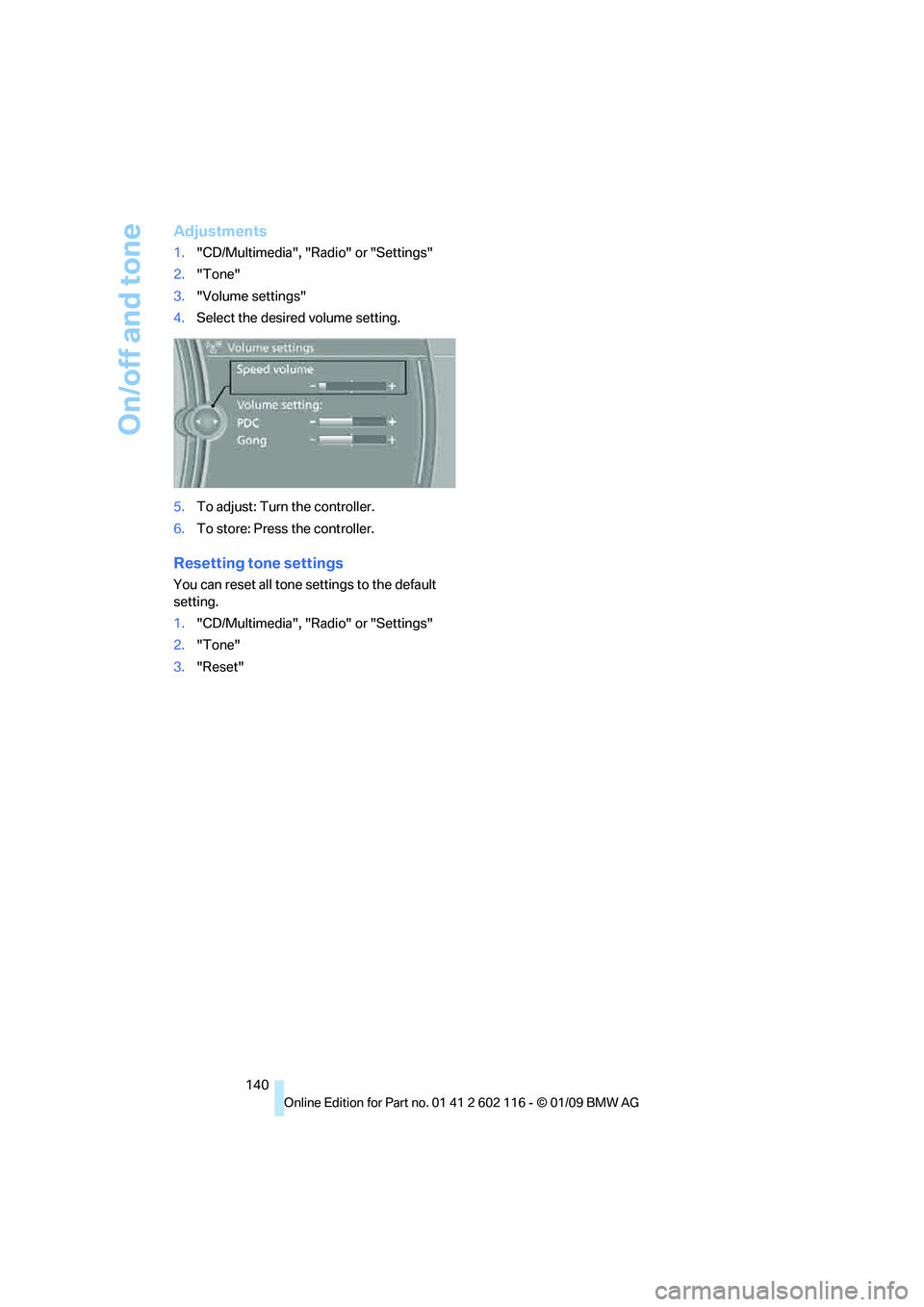
On/off and tone
140
Adjustments
1."CD/Multimedia", "Radio" or "Settings"
2. "Tone"
3. "Volume settings"
4. Select the desired volume setting.
5. To adjust: Turn the controller.
6. To store: Press the controller.
Resetting tone settings
You can reset all tone settings to the default
setting.
1. "CD/Multimedia", "Radio" or "Settings"
2. "Tone"
3. "Reset"
Page 145 of 248
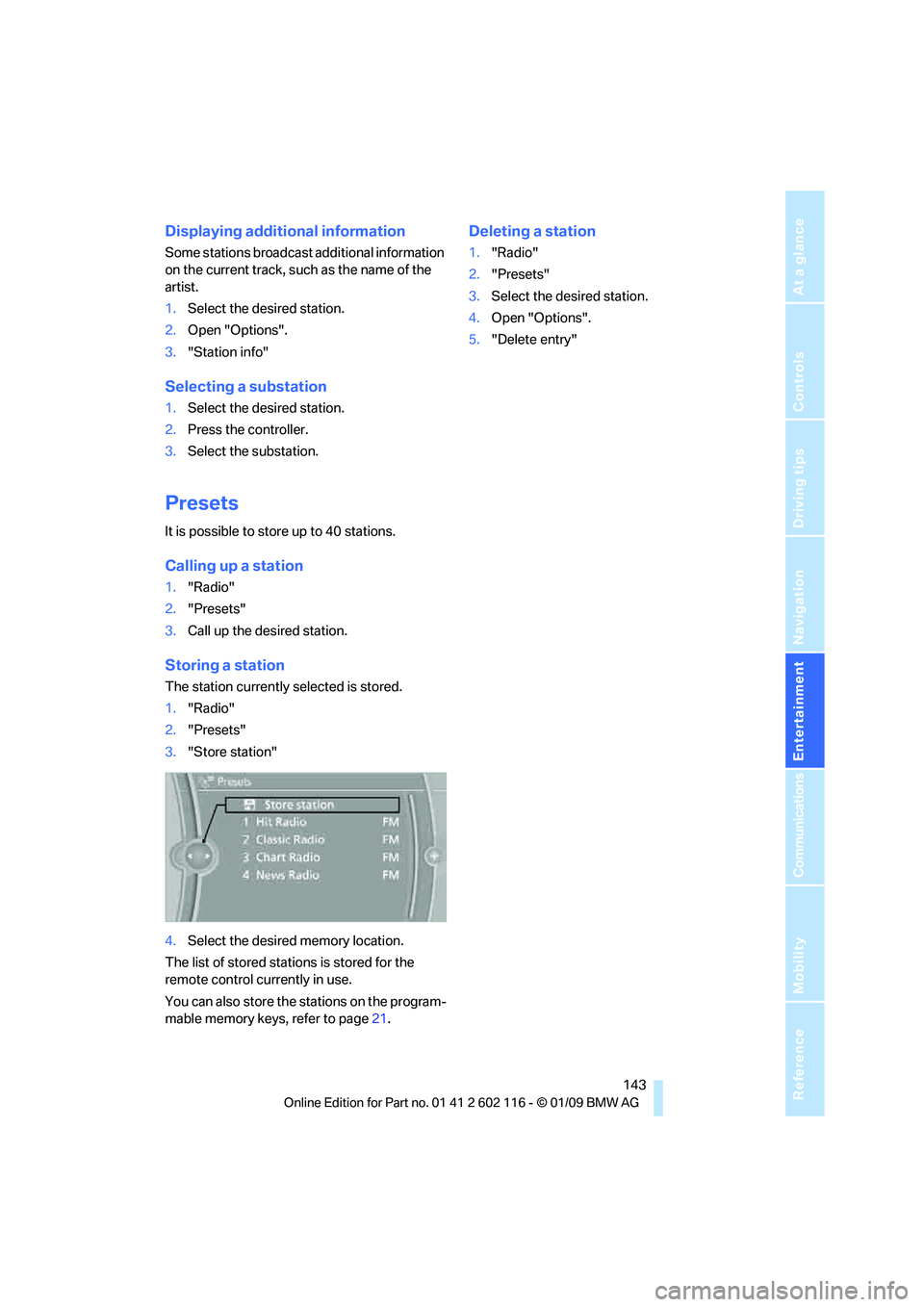
Navigation
Entertainment
Driving tips
143Reference
At a glance
Controls
Communications
Mobility
Displaying additional information
Some stations broadcast additional information
on the current track, such as the name of the
artist.
1.Select the desired station.
2. Open "Options".
3. "Station info"
Selecting a substation
1.Select the desired station.
2. Press the controller.
3. Select the substation.
Presets
It is possible to stor e up to 40 stations.
Calling up a station
1."Radio"
2. "Presets"
3. Call up the desired station.
Storing a station
The station currently selected is stored.
1."Radio"
2. "Presets"
3. "Store station"
4. Select the desired memory location.
The list of stored stations is stored for the
remote control currently in use.
You can also store the st ations on the program-
mable memory keys, refer to page 21.
Deleting a station
1."Radio"
2. "Presets"
3. Select the desired station.
4. Open "Options".
5. "Delete entry"
Page 167 of 248
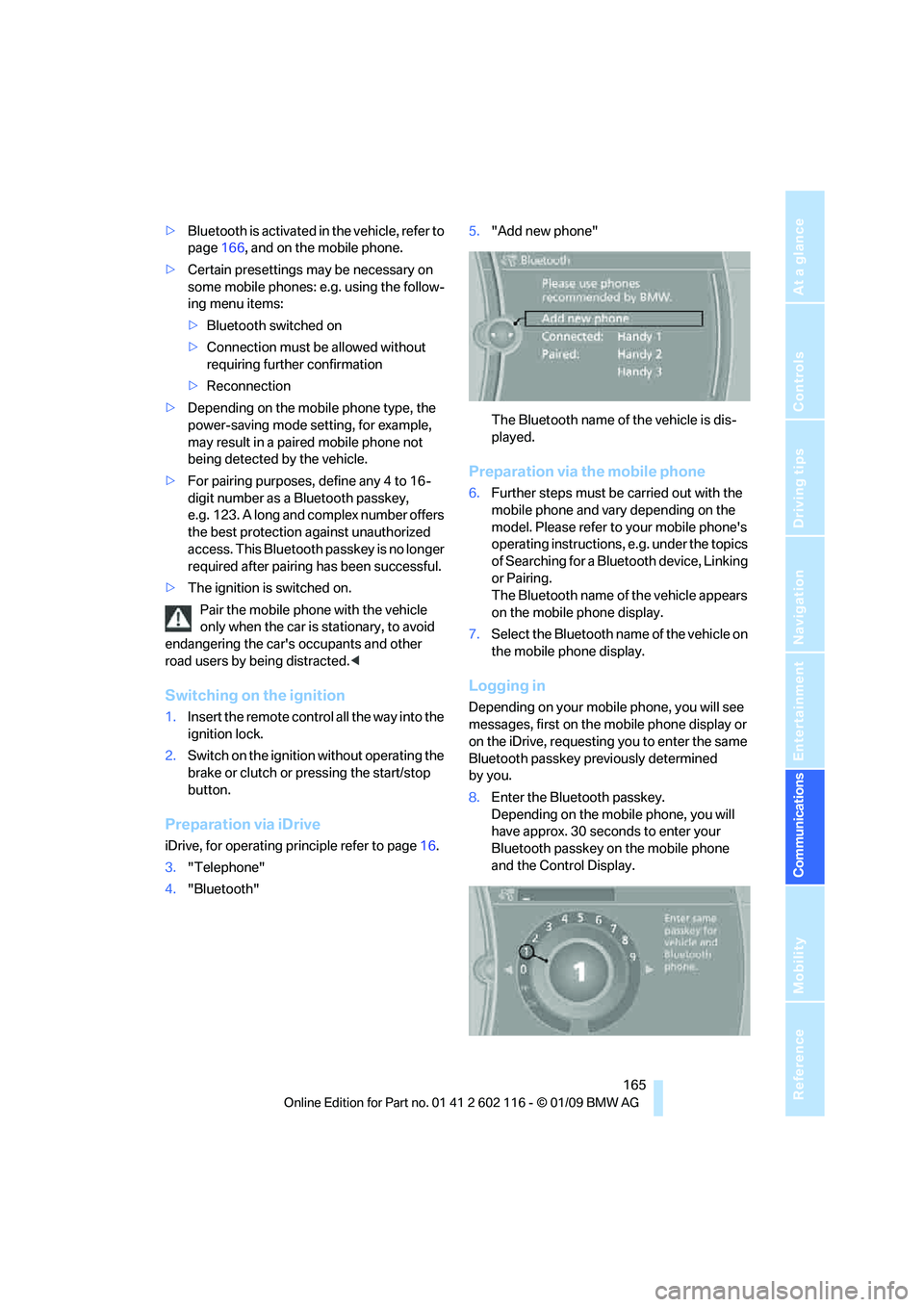
165
Entertainment
Reference
At a glance
Controls
Driving tips
Communications
Navigation
Mobility
> Bluetooth is activated in the vehicle, refer to
page 166, and on the mobile phone.
> Certain presettings ma y be necessary on
some mobile phones: e.g. using the follow-
ing menu items:
> Bluetooth switched on
> Connection must be allowed without
requiring further confirmation
> Reconnection
> Depending on the mobile phone type, the
power-saving mode setting, for example,
may result in a paired mobile phone not
being detected by the vehicle.
> For pairing purposes, define any 4 to 16-
digit number as a Bluetooth passkey,
e.g. 123. A long and complex number offers
the best protection against unauthorized
access. This Bluetooth passkey is no longer
required after pairing has been successful.
> The ignition is switched on.
Pair the mobile phone with the vehicle
only when the car is stationary, to avoid
endangering the car's occupants and other
road users by be ing distracted.<
Switching on the ignition
1.Insert the remote contro l all the way into the
ignition lock.
2. Switch on the ignition without operating the
brake or clutch or pressing the start/stop
button.
Preparation via iDrive
iDrive, for operating principle refer to page 16.
3. "Telephone"
4. "Bluetooth" 5.
"Add new phone"
The Bluetooth name of the vehicle is dis-
played.
Preparation via the mobile phone
6.Further steps must be carried out with the
mobile phone and vary depending on the
model. Please refer to your mobile phone's
operating instructions, e.g. under the topics
of Searching for a Bluetooth device, Linking
or Pairing.
The Bluetooth name of the vehicle appears
on the mobile phone display.
7. Select the Bluetooth na me of the vehicle on
the mobile phone display.
Logging in
Depending on your mob ile phone, you will see
messages, first on the mobile phone display or
on the iDrive, requesting you to enter the same
Bluetooth passkey previously determined
by you.
8. Enter the Bluetooth passkey.
Depending on the mobile phone, you will
have approx. 30 seco nds to enter your
Bluetooth passkey on the mobile phone
and the Control Display.
Page 227 of 248
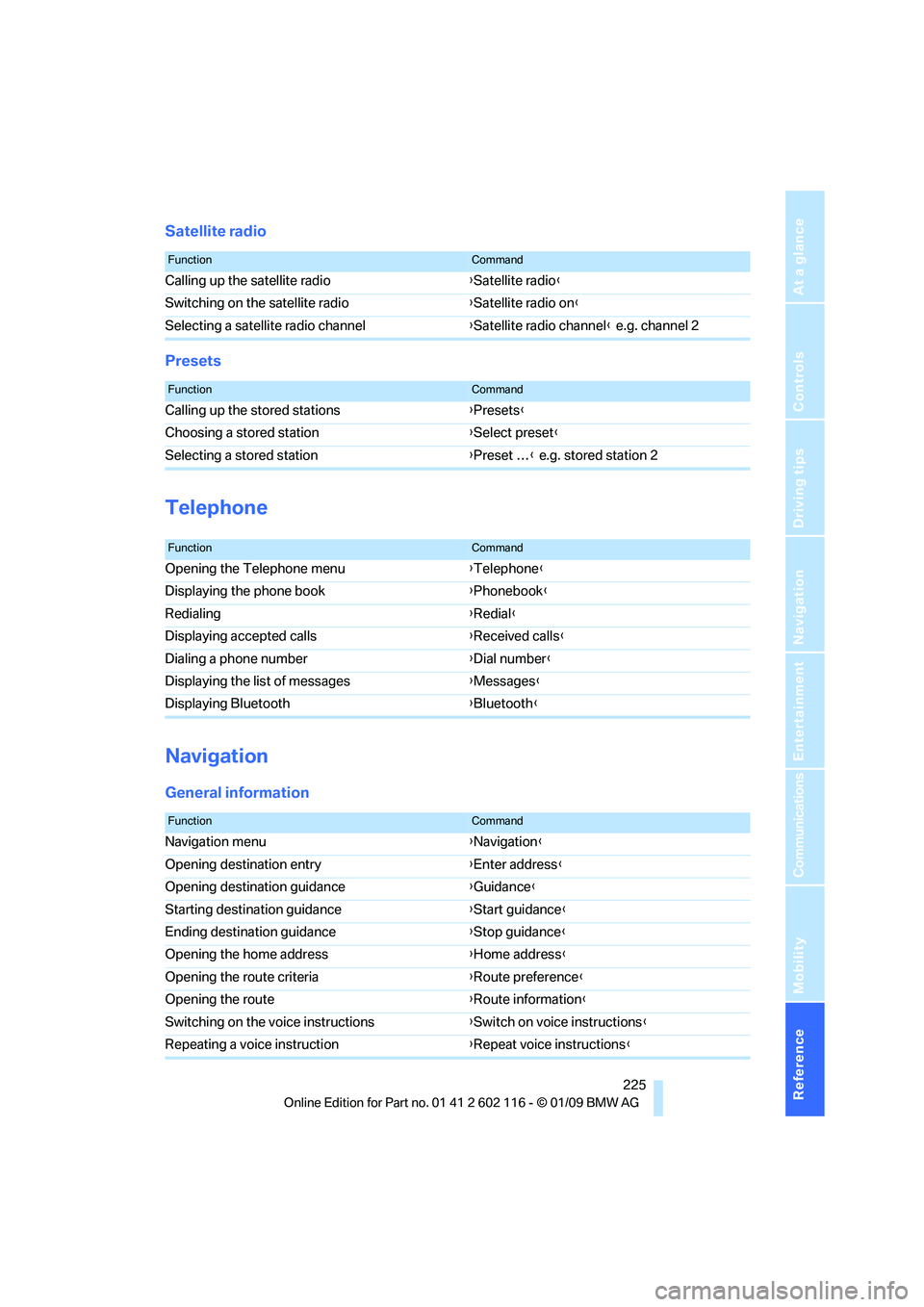
Reference 225
At a glance
Controls
Driving tips
Communications
Navigation
Entertainment
Mobility
Satellite radio
Presets
Telephone
Navigation
General information
FunctionCommand
Calling up the satellite radio{Satellite radio}
Switching on the satellite radio {Satellite radio on }
Selecting a satellite radio channel {Satellite radio channel } e.g. channel 2
FunctionCommand
Calling up the stored stations {Presets }
Choosing a stored station {Select preset }
Selecting a stored station {Preset … } e.g. stored station 2
FunctionCommand
Opening the Telephone menu {Telephone }
Displaying the phone book {Phonebook }
Redialing {Redial }
Displaying accepted calls {Received calls }
Dialing a phone number {Dial number }
Displaying the list of messages {Messages}
Displaying Bluetooth {Bluetooth }
FunctionCommand
Navigation menu {Navigation }
Opening destination entry {Enter address }
Opening destination guidance {Guidance}
Starting destination guidance {Start guidance }
Ending destination guidance {Stop guidance }
Opening the home address {Home address }
Opening the route criteria {Route preference }
Opening the route {Route information }
Switching on the voice instructions {Switch on voice instructions }
Repeating a voice instruction {Repeat voice instructions }
Page 241 of 248

Reference 239
At a glance
Controls
Driving tips
Communications
Navigation
Entertainment
Mobility
Parking lamps/low beams88
Passenger-side mirror tilt
function 46
Pathway lighting 89
Personal Profile 28
Phone book 167
Phone numbers
– dialing 168
Pinch protection system
– windows 37
Placing a call, refer to
telephone owner's manual
Playback lists for external
devices 160
Polish 207
Pollen
– refer to Microfilter/activated- charcoal filter for automatic
climate control 97
– refer to Microfilter for air conditioner 94
Position, refer to Current
position, displaying 134
Postal code, entering for navigation 120
Power failure 212
Power windows 37
Power windows, refer to
Windows 36
Pressure, tires 190
Pressure monitoring, tires 81
– Flat Tire Monitor 81
Pressure monitoring of tires, refer to Tire Pressure
Monitor TPM 82
Programmable buttons on the steering wheel 11
Protection function, refer to Pinch protection system
– windows 37
Providing medical assistance, refer to First add pouch 214
Puncture
– Flat Tire Monitor 81R
Radio
– controls138
– High Definition Radio 142
– satellite radio 144
– selecting a waveband 141
– storing stations 142
– switching on/off 138
– tone control 138
– volume 138
– Weather Band, refer to Weather information 144
Radio position, refer to Radio readiness 50
Radio readiness 50
– switched off 50
– switched on 50
Radio-remote key, refer to
Remote control with
integrated key 28
Rain sensor 60
Random sequence
– CD/DVD changer 147
– CD/DVD player 147
Reading lamps 91
Rear fog lamps
– indicator lamp 13
Rear lamp, refer to Tail lamps
– replacing bulb 210
Rear lamps, refer to
Tail lamps 210
Rear turn signals
– replacing bulb 210
Rearview mirror, refer to Mirrors 45
Rear window defroster 94,97
Receiving level of mobile phone, refer to Status
information 20
Reception
– quality 142
– radio station 142
Recirculated-air mode 93,97
Recirculation of air, refer to Recirculated-air
mode 93,97 Reclining seat, refer to
Backrest 42
Refueling 188
Releasing
– hood 197
Remaining distance, refer to Cruising range 65
Remote control 28
– battery renewal 36
– convenient access 35
– garage door opener 98
– luggage compartment lid 30
– malfunction 31,36
– removing from the ignition lo
ck50
– service data 202
Replacement remote control 28
Replacing bulbs, refer to
Lamps and bulbs 208
Replacing tires 195
Replacing tires, refer to New
wheels and tires 195
Reporting safety defects 7
Reserve warning, refer to Fuel
gauge 65
Reset, refer to Resetting tone settings 140
Restraint systems
– for children 48
– refer to Safety belts 44
Retractable hardtop
– care, refer to Caring for your vehicle brochure
– convenient operation 30
– opening and closing 39
– remote control 30
retractable hardtop 38
Reverse
– CD/DVD changer 148
– CD/DVD player 148
Reverse gear 57
– automatic transmission with
Steptronic 54
– manual transmission 53
Road map 130
Roadside Assistance 179,213
Page 244 of 248
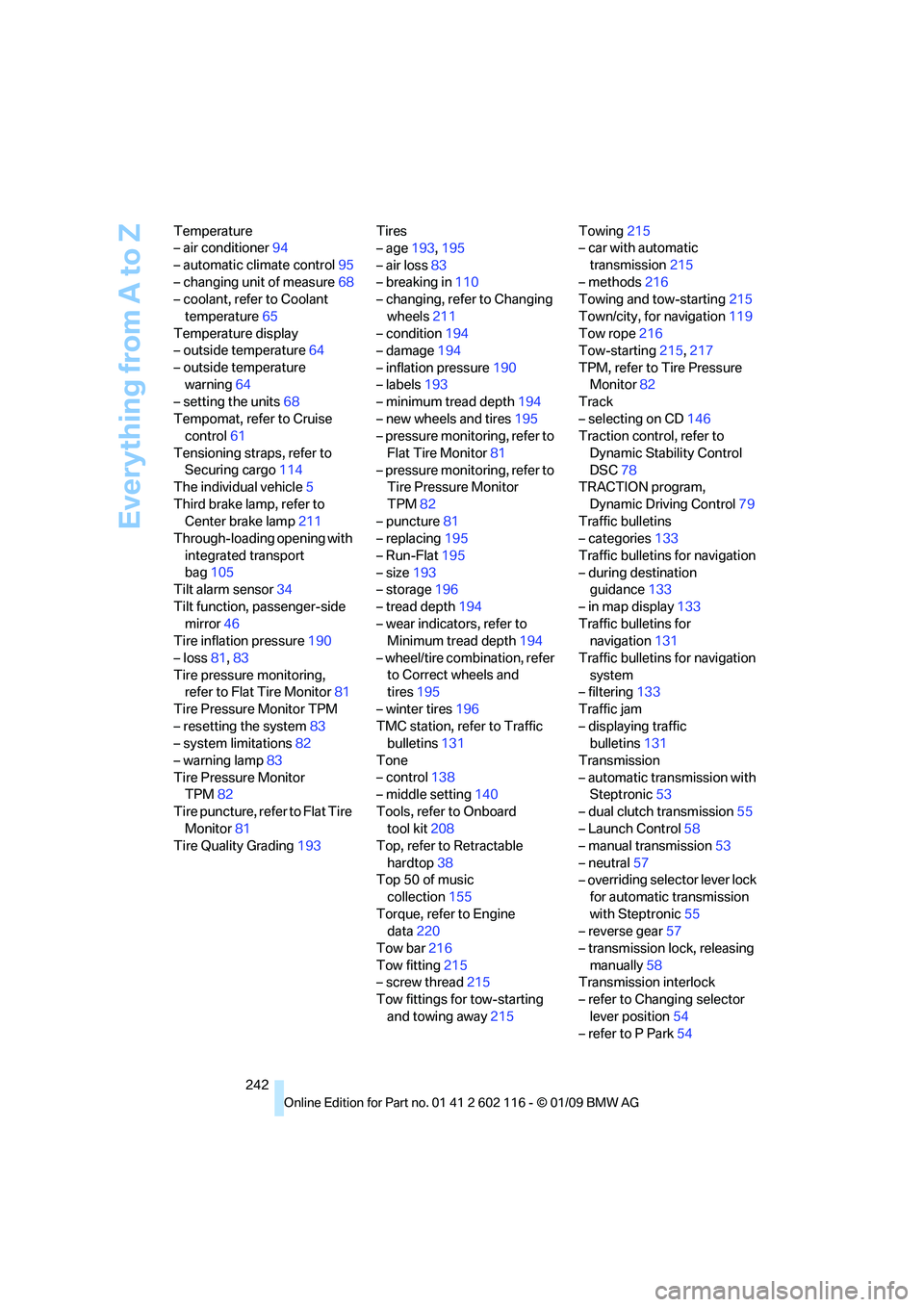
Everything from A to Z
242
Temperature
– air conditioner
94
– automatic climate control 95
– changing unit of measure 68
– coolant, refer to Coolant
temperature 65
Temperature display
– outside temperature 64
– outside temperature warning 64
– setting the units 68
Tempomat, refer to Cruise control 61
Tensioning straps, refer to Securing cargo 114
The individual vehicle 5
Third brake lamp, refer to Center brake lamp 211
Through-loading opening with
integrated transport
bag 105
Tilt alarm sensor 34
Tilt function, passenger-side mirror 46
Tire inflation pressure 190
– loss 81,83
Tire pressure monitoring, refer to Flat Tire Monitor 81
Tire Pressure Monitor TPM
– resetting the system 83
– system limitations 82
– warning lamp 83
Tire Pressure Monitor TPM 82
Tire puncture, refer to Flat Tire Monitor 81
Tire Quality Grading 193Tires
– age
193,195
– air loss 83
– breaking in 110
– changing, refer to Changing
wheels 211
– condition 194
– damage 194
– inflation pressure 190
– labels 193
– minimum tread depth 194
– new wheels and tires 195
– pressure monitoring, refer to
Flat Tire Monitor 81
– pressure monitoring, refer to Tire Pressure Monitor
TPM 82
– puncture 81
– replacing 195
– Run-Flat 195
– size 193
– storage 19
6
– tread depth 194
– wear indicators, refer to Minimum tread depth 194
– wheel/tire combination, refer to Correct wheels and
tires 195
– winter tires 196
TMC station, refer to Traffic bulletins 131
Tone
– control 138
– middle setting 140
Tools, refer to Onboard tool kit 208
Top, refer to Retractable
hardtop 38
Top 50 of music collection 155
Torque, refer to Engine data 220
Tow bar 216
Tow fitting 215
– screw thread 215
Tow fittings for tow-starting
and towing away 215Towing
215
– car with automatic
transmission 215
– methods 216
Towing and tow-starting 215
Town/city, for navigation 119
Tow rope 216
Tow-starting 215,217
TPM, refer to Tire Pressure Monitor 82
Track
– selecting on CD 146
Traction control, refer to
Dynamic Stability Control
DSC 78
TRACTION program,
Dynamic Driving Control 79
Traffic bulletins
– categories 133
Traffic bulletins for navigation
– during destination guidance 133
– in map display 133
Traffic bulletins for navigation 131
Traffic bulletins for navigation system
– filtering 133
Traffic jam
– displaying traffic bulletins 131
Transmission
– automatic transmission with Steptronic 53
– dual clutch transmission 55
– Launch Control 58
– manual transmission 53
– neutral 57
– ov
erriding selector lever lock
for automatic transmission
with Steptronic 55
– reverse gear 57
– transmission lock, releasing
manually 58
Transmission interlock
– refer to Changing selector
lever position 54
– refer to P Park 54